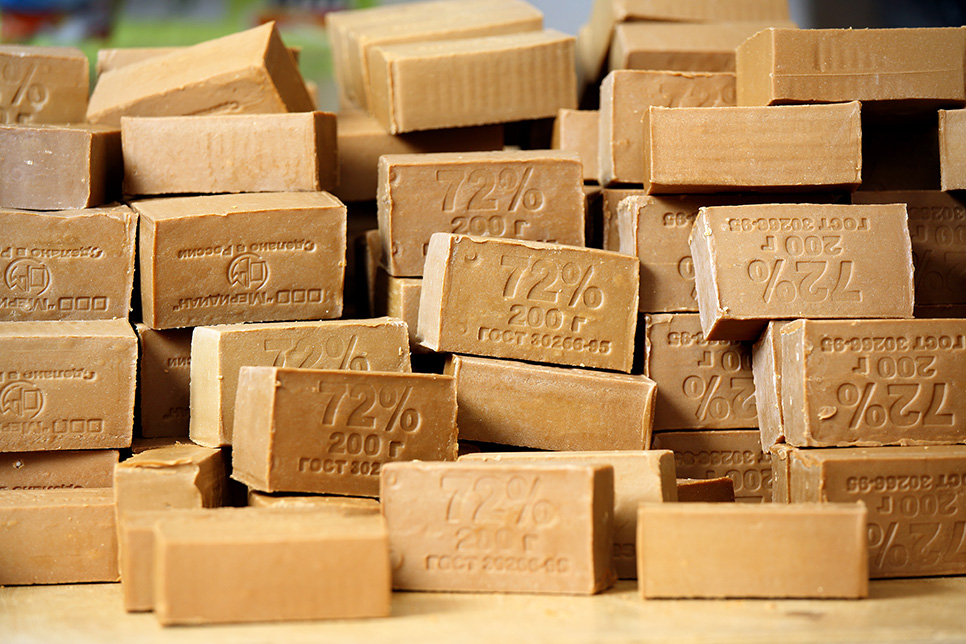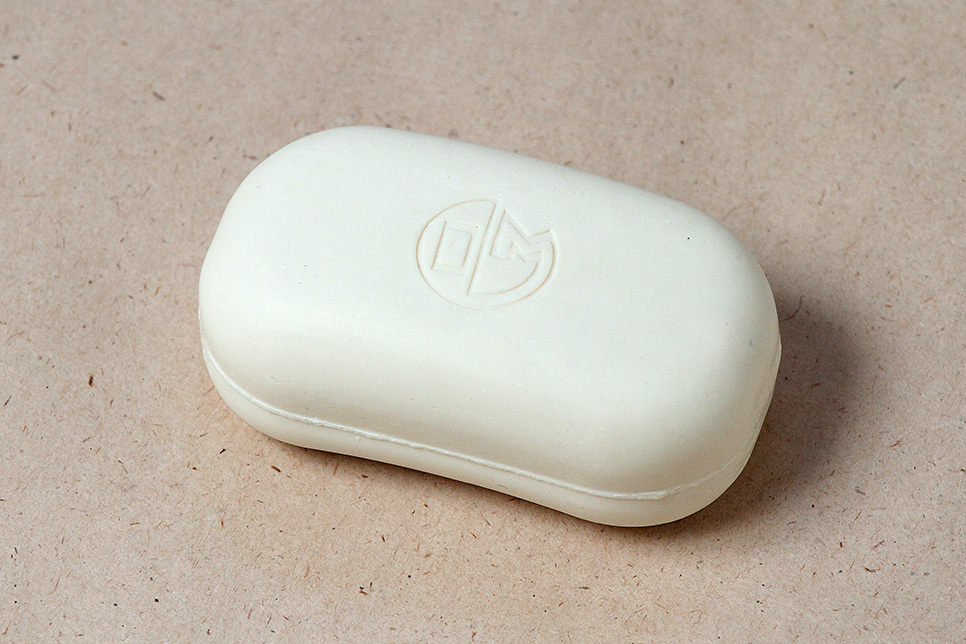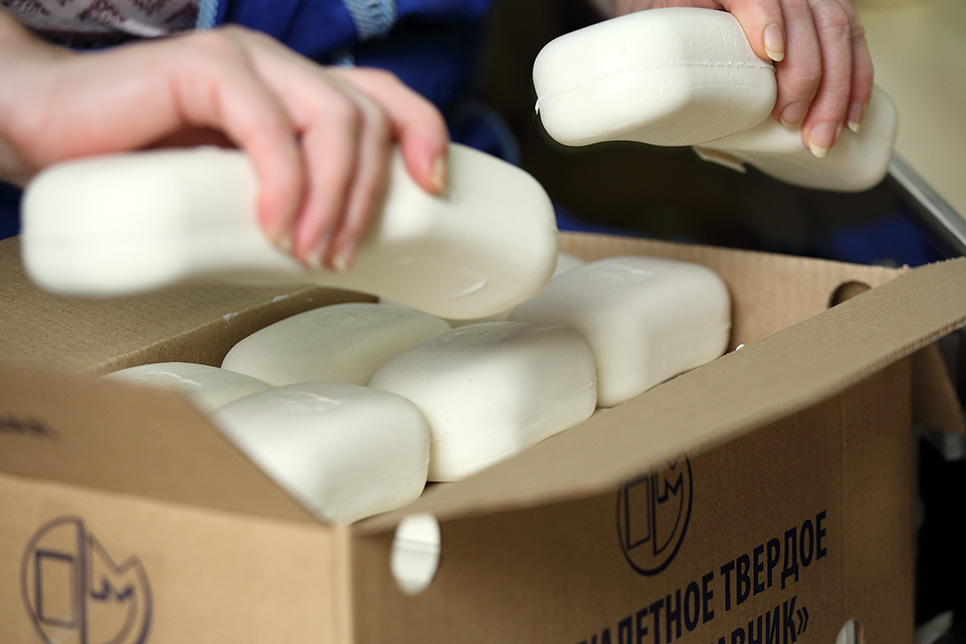About soap

What is soap?
Classical soap - is a cleansing agent created by the chemical reaction of a fatty acid with an alkali metal hydroxide. Chemically speaking, it is a salt composed of an alkalimetal, such as sodium or potassium, and a mixture of "fatty" carboxylic acids. The cleansing action of soap comes from its unique ability to surround oil particles, causing them to be dispersed in water and easily rinsed away. Soap has been used for centuries and continues to be widely used as a cleansing agent, mild antiseptic and ingestible antidote to some forms of poisoning.Human skin is covered by thin fatty membrane, which retains moisture in deep layers of skin and prevents bacterium and other environmental hazards from falling into your body.The membrane collects all dirt.It is necessary to wash it away to produce new fatty membrane. But you can’t do it with clean water only.
How does soap work?
Water, the liquid commonly used for cleaning, has a property called surface tension. In the body of the water, each molecule is surrounded and attracted by other water molecules. However, at the surface, those molecules are surrounded by other water molecules only on the water side. A tension is created as the water molecules at the surface are pulled into the body of the water. This tension causes water to bead up on surfaces which slows wetting of the surface and inhibits the cleaning process. In the cleaning process, surface tension must be reduced so water can spread and wet surfaces. Chemicals that are able to do this effectively are called surface active agents, or surfactants. Soap is an anionic surfactant. Other anionic as well as nonionic surfactants are the main ingredients in today's detergents. Most of what we call dirt is grease or oil which will not come off with just water. This is because oil and grease are non-polar, which means they will not dissolve in the water.Soap can mix with both water and with oil. The soap molecule has two different ends, one that is hydrophilic (polar head) that binds with water and the other that is hydrophobic (non-polar hydrocarbon tail) that binds with grease and oil.When greasy dirt is mixed with soapy water, the soap molecules arrange themselves into tiny clusters called micelles.The hydrophilic part of the soap molecules sticks to the water and points outwards, forming the outer surface of the micelle.The hydrophobic parts stick to the oil and trap oil in the center where it can't come into contact with the water. With the oil tucked safely in the center, the micelle is soluble in water. As the soapy water is rinsed away the greasy dirt goes along with it.


History of soap making
The first detergent was simple water. Although in streamless areas people used sand to wash away spots. The earliest soaps being mixes of oils with fire ash, clay or sand. Soap making was based around the same process: boiling oils and fats with an alkali to produce soap and glycerine. The earliest recorded evidence of the production of soap-like materials dates back to around 2800 BC in ancient Babylon. A formula for soap consisting of water, alkali, and cassia oil was written on a Babylonian clay tablet around 2200 BC.A popular belief says that soap takes its name from a supposed Mount Sapo, where animal sacrifices were supposed to have taken place; tallow from these sacrifices would then have mixed with ashes from fires associated with these sacrifices and with water to produce soap, Roman animal sacrifices usually burned only the bones and inedible entrails of the sacrificed animals; edible meat and fat from the sacrifices were taken by the humans rather than the gods.The word sapo appears in Pliny the Elder's Historia Naturalis, which discusses the manufacture of soap from tallow and ashes, he also mentions use for it is as a pomade for hair. The remains of what might have been a soap factory were discovered in Pompeii, which was overwhelmed by an eruption of Vesuvius in 79AD. From the 17th century soaps established in Europe. Significant role in the development of soap making has played a geographical factor. Ingredients for soap preparation was varied depending on the region. In the north was used animal fat, and in the south – olive oil, thanks to which the soap turned out excellent quality.Since IX century, a major supplier of soap in Europe became Marseille, thanks to the presence in the surrounding area of primary sources, olive oil and soda. The oil extracted after the first two pressings was used for food, and after the third was used for soap making.Only since the end of the XIV century Marseilles soap ceded its place in the international trade of the Venetian. As well soap-making actively developed in Italy, Greece and Spain.In the XV century, in Italy, in Sevan, for the first time started to produce a solid soap industrially. In this case fat is not connected with the ash and the natural soda. This significantly reduces the cost of soap, and therefore transferred from the category of soap-making craftsmanship in the manufacturing.From the XIV century, soap factories began to appear in Germany. For a soap boiling process were used fats of beef, lamb, pork, horse, bones, whale fish, and the waste fats of different industries.In Russia soap-making started at the times of Peter I, but up to the middle of XIX it was used by nobles only. Peasants used soap lye to wash and bath. Shuya was a major supplier of soap in Russia. Moscow manufacturers such as Ladygyn’s factory, factory of Alfons Rale and Brocar’s perfume factory were widely known. Brocar’s factory produced cheap soap for all social groups. Due to special economic circumstances, first soap manufacturers appeared in Russia in XVIII. Although there was a developed soap production chemical aspect weren’t clear. The science of modern soapmaking was born some in 1811 with the discovery by Michel Eugene Chevreul, French chemist, of the chemical nature and relationship of fats, glycerine and fatty acids. His studies established the basis for both fat and soap chemistry.
Technology of soap producing
Hot process. Hot-processed soaps are created by encouraging the saponification reaction by adding heat to speed up the reaction. In the hot process, the hydroxide and the fat are heated and mixed together at 80–100 °C, a little below boiling point, until saponification is complete, which, before modern scientific equipment, the soapmaker determined by taste or by eye; the experienced eye can tell when gel stage and full saponification has occurred. An advantage of the fully boiled hot process in soapmaking is the exact amount of hydroxide required need not be known with great accuracy. They originated when the purity of the alkali hydroxides were unreliable, as these processes can use even naturally found alkalis, such as wood ashes and potash deposits. In the fully boiled process, the mix is actually boiled (100+ °C), and, after saponification has occurred, the "neat soap" is precipitated from the solution by adding common salt, and the excess liquid is drained off. This excess liquid carries away with it much of the impurities and color compounds in the fat, to leave a purer, whiter soap, and with practically all the glycerine removed. The hot, soft soap is then pumped into a mold. The spent hydroxide solution is processed for recovery of glycerine.Cold process. A cold-process soapmaker first looks up the saponification value for each unique fat on an oil specification sheet. Oil specification sheets contain laboratory test results for each fat, including the precise saponification value of the fat. The saponification value must be converted into an equivalent sodium hydroxide value for use in cold process soapmaking. Excess unreacted lye in the soap results in a very high pH and can burn or irritate skin, whereas not enough lye leaves the soap greasy. Most soap makers formulate their recipes with a 2–5% deficit of lye, to account for the unknown deviation of saponification value between their oil batch and laboratory averages.The lye is dissolved in water. Then, the oils are heated, or melted if they are solid at room temperature. Once the oils are liquefied and the lye is fully dissolved in water, they are combined. This lye-fat mixture is mixed until the two phases (oils and water) are fully emulsified. Varying levels of trace can occur at each stage of the saponification process. Depending on how additives affect trace, they may be added at light trace, medium trace, or heavy trace. After much stirring, the mixture turns to the consistency of a thin pudding. "Trace" corresponds roughly to viscosity. Essential oils and fragrance oils can be added with the initial soaping oils, but solid additives such as botanicals, herbs, oatmeal, or other additives are most commonly added at light trace, just as the mixture starts to thicken.The batch is then poured into molds, kept warm with towels or blankets, and left to continue saponification for 12 to 48 hours. After the insulation period, the soap is firm enough to be removed from the mold and cut into bars. At this time, it is safe to use the soap, since saponification is in essence complete. Melting. To make melt and pour soap, cut your chosen soap base into cubes using the perforated grid on the block as a guideline. Each cut cube is approximately 1 ounce. Heat water to boiling in the bottom pot of a double boiler. Then, reduce heat to simmer. In the top pot of the boiler, add the soap cubes. Stir frequently until they have melted. Then add any desired colorant, clays or other additives (except for solid ingredients and essential/fragrance oils), and stir until well incorporated. Immediately remove your melted soap from of the stove, and let it cool slightly. Stir the soap frequently as it cools. Add your desired fragrance, and stir well. It's best that you wait until the soap has cooled before adding essential or fragrance oils so that the oils don't evaporate before the soap cools. After the soap has cooled slightly, it can be poured into molds. Your soap should be ready to unmold within 2 hours.


Use of soap
Soap plays an important role in life of modern society. Soap prevents transmission of diseases. In textile industry water-insoluble soap is used for manufacturing of waterproof fabric; in metal working soap is used for metal protection against the corrosion and as lubricant in wire production; a leather industry uses soap to make leather waterproof; oil products and enameled soap are used to produce the synthetic rubber in rubber industry; many shampoos and creams are made of organic alkalis. Soap may also be used as an emulsifier for insecticides and other chemicals.The stearate zinc soap is a water-repellent talcum powder. Calcium, magnesium and aluminum soap are used in oil fractions for gasoline gelling which are used in production of canned heat and lubricants. In shipping industry soap is used as the basis for non-fouling paint and as seaweed inhibitors. Paint industry uses soap as the basis for drying and matting substances. Soap is also used as lubricant for plastic masses and antiseptic and detergent substance in food industry.
